
Heart Torso Head Arm Leg Blood
The Cardiovascular System
Your heart and circulatory system make up your cardiovascular system. Your heart works as a pump that pushes blood to the organs, tissues, and cells of your body. Blood delivers oxygen and nutrients to every cell and removes the carbon dioxide and waste products made by those cells. Blood is carried from your heart to the rest of your body through a complex network of arteries, arterioles, and capillaries. Blood is returned to your heart through venules and veins. If all the vessels of this network in your body were laid end-to-end, they would extend for about 60,000 miles (more than 96,500 kilometers), which is far enough to circle the earth more than twice!The one-way circulatory system carries blood to all parts of your body. This process of blood flow within your body is called circulation. Arteries carry oxygen-rich blood away from your heart, and veins carry oxygen-poor blood back to your heart.
In pulmonary circulation, though, the roles are switched. It is the pulmonary artery that brings oxygen-poor blood into your lungs and the pulmonary vein that brings oxygen-rich blood back to your heart.In the diagram, the vessels that carry oxygen-rich blood are colored red, and the vessels that carry oxygen-poor blood are colored blue.
Twenty major arteries make a path through your tissues, where they branch into smaller vessels called arterioles. Arterioles further branch into capillaries, the true deliverers of oxygen and nutrients to your cells. Most capillaries are thinner than a hair. In fact, many are so tiny, only one blood cell can move through them at a time. Once the capillaries deliver oxygen and nutrients and pick up carbon dioxide and other waste, they move the blood back through wider vessels called venules. Venules eventually join to form veins, which deliver the blood back to your heart to pick up oxygen.
| Heart Anatomy | |
The heart weighs between 7 and 15 ounces (200 to 425 grams) and is a little larger than the size of your fist. By the end of a long life, a person's heart may have beat (expanded and contracted) more than 3.5 billion times. In fact, each day, the average heart beats 100,000 times, pumping about 2,000 gallons (7,571 liters) of blood.
Your heart has 4 chambers. The upper chambers are called the left and right atria, and the lower chambers are called the left and right ventricles. A wall of muscle called the septum separates the left and right atria and the left and right ventricles. The left ventricle is the largest and strongest chamber in your heart. The left ventricle's chamber walls are only about a half-inch thick, but they have enough force to push blood through the aortic valve and into your body.
The Heart Valves (illustration)
Four types of valves regulate blood flow through your heart:
- The tricuspid valve regulates blood flow between the right atrium and right ventricle.
- The pulmonary valve controls blood flow from the right ventricle into the pulmonary arteries, which carry blood to your lungs to pick up oxygen.
- The mitral valve lets oxygen-rich blood from your lungs pass from the left atrium into the left ventricle.
- The aortic valve opens the way for oxygen-rich blood to pass from the left ventricle into the aorta, your body's largest artery, where it is delivered to the rest of your body.
See also on this site: The Heartbeat
The Conduction System (illustration)Electrical impulses from your heart muscle (the myocardium) cause your heart to contract. This electrical signal begins in the sinoatrial (SA) node, located at the top of the right atrium. The SA node is sometimes called the heart's "natural pacemaker." An electrical impulse from this natural pacemaker travels through the muscle fibers of the atria and ventricles, causing them to contract. Although the SA node sends electrical impulses at a certain rate, your heart rate may still change depending on physical demands, stress, or hormonal factors.
The Circulatory System (illustration)
Your heart and circulatory system make up your cardiovascular system. Your heart works as a pump that pushes blood to the organs, tissues, and cells of your body. Blood delivers oxygen and nutrients to every cell and removes the carbon dioxide and waste products made by those cells. Blood is carried from your heart to the rest of your body through a complex network of arteries, arterioles, and capillaries. Blood is returned to your heart through venules and veins. If all the vessels of this network in your body were laid end-to-end, they would extend for about 60,000 miles (more than 96,500 kilometers), which is far enough to circle the earth more than twice!
| Vasculature of the Torso | |

The one-way circulatory system carries blood to all parts of your body. This process of blood flow within your body is called circulation. Arteries carry oxygen-rich blood away from your heart, and veins carry oxygen-poor blood back to your heart.
In pulmonary circulation, though, the roles are switched. It is the pulmonary artery that brings oxygen-poor blood into your lungs and the pulmonary vein that brings oxygen-rich blood back to your heart.In the diagram, the vessels that carry oxygen-rich blood are colored red, and the vessels that carry oxygen-poor blood are colored blue.
| Vasculature of the Head | |
 |
Veins of the Head and Upper Torso
The one-way circulatory system carries blood to all parts of your body. This process of blood flow within your body is called circulation. Arteries carry oxygen-rich blood away from your heart, and veins carry oxygen-poor blood back to your heart.
In pulmonary circulation, though, the roles are switched. It is the pulmonary artery that brings oxygen-poor blood into your lungs and the pulmonary vein that brings oxygen-rich blood back to your heart.In the diagrams, the vessels that carry oxygen-rich blood are colored red, and the vessels that carry oxygen-poor blood are colored blue.
| Vasculature of the Arm | |
The one-way circulatory system carries blood to all parts of your body. This process of blood flow within your body is called circulation. Arteries carry oxygen-rich blood away from your heart, and veins carry oxygen-poor blood back to your heart.
In pulmonary circulation, though, the roles are switched. It is the pulmonary artery that brings oxygen-poor blood into your lungs and the pulmonary vein that brings oxygen-rich blood back to your heart.In the diagram, the vessels that carry oxygen-rich blood are colored red, and the vessels that carry oxygen-poor blood are colored blue.
| Vasculature of the Leg | |
The one-way circulatory system carries blood to all parts of your body. This process of blood flow within your body is called circulation. Arteries carry oxygen-rich blood away from your heart, and veins carry oxygen-poor blood back to your heart.
In pulmonary circulation, though, the roles are switched. It is the pulmonary artery that brings oxygen-poor blood into your lungs and the pulmonary vein that brings oxygen-rich blood back to your heart.In the diagram, the vessels that carry oxygen-rich blood are colored red, and the vessels that carry oxygen-poor blood are colored blue.
| Blood | |
The circulatory system is the route by which the cells in your body get the oxygen and nutrients they need, but blood is the actual carrier of the oxygen and nutrients. Blood is made mostly of plasma, which is a yellowish liquid that is 90% water. But in addition to the water, plasma contains salts, sugar (glucose), and other substances. And, most important, plasma contains proteins that carry important nutrients to the body’s cells and strengthen the body’s immune system so it can fight off infection.
The average man has between 10 and 12 pints of blood in his body. The average woman has between 8 and 9 pints. To give you an idea of how much blood that is, 8 pints is equal to 1 gallon (think of a gallon of milk).
What is blood?
Blood is actually a tissue. It is thick because it is made up of a variety of cells, each having a different job. In fact, blood is actually about 80% water and 20% solid.
We know that blood is made mostly of plasma. But there are 3 main types of blood cells that circulate with the plasma:
 Platelets, which help the blood to clot. Clotting stops the blood from flowing out of the body when a vein or artery is broken. Platelets are also called thrombocytes.
Platelets, which help the blood to clot. Clotting stops the blood from flowing out of the body when a vein or artery is broken. Platelets are also called thrombocytes.- Red blood cells, which carry oxygen. Of the 3 types of blood cells, red blood cells are the most plentiful. In fact, a healthy adult has about 35 trillion of them. The body creates these cells at a rate of about 2.4 million a second, and they each have a life span of about 120 days. Red blood cells are also called erythrocytes.
- White blood cells, which ward off infection. These cells, which come in many shapes and sizes, are vital to the immune system. When the body is fighting off infection, it makes them in ever-increasing numbers. Still, compared to the number of red blood cells in the body, the number of white blood cells is low. Most healthy adults have about 700 times as many red blood cells as white ones. White blood cells are also called leukocytes.
What does blood do?
Blood carries oxygen from the lungs and nutrients from the digestive tract to the body’s cells. It also carries away carbon dioxide and all of the waste products that the body does not need. (The kidneys filter and clean the blood.) Blood also
- Helps keep your body at the right temperature
- Carries hormones to the body’s cells
- Sends antibodies to fight infection
- Contains clotting factors to help the blood to clot and the body’s tissues to heal
There are 4 different blood types: A, B, AB, and O. Genes that you inherit from your parents (1 from your mother and 1 from your father) determine your blood type.
Blood is always being made by the cells inside your bones, so your body can usually replace any blood lost through small cuts or wounds. But when a lot of blood is lost through large wounds, it has to be replaced through a blood transfusion (blood donated by other people). In blood transfusions, the donor and recipient blood types must be compatible. People with type O blood are called universal donors, because they can donate blood to anyone, but they can only receive a transfusion from other people with type O blood.









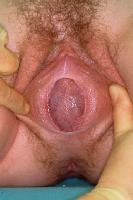
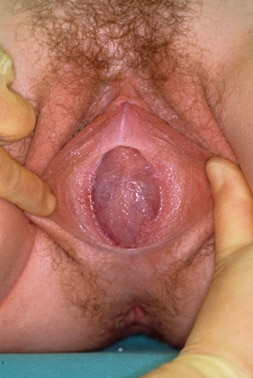
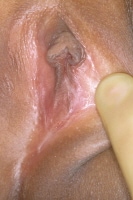
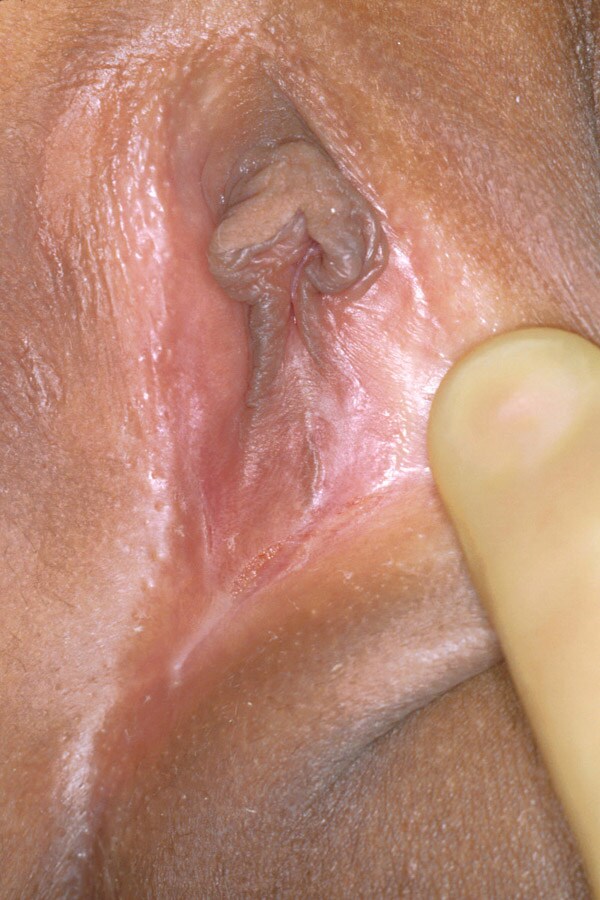
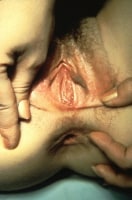

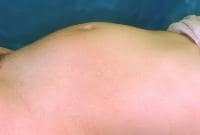
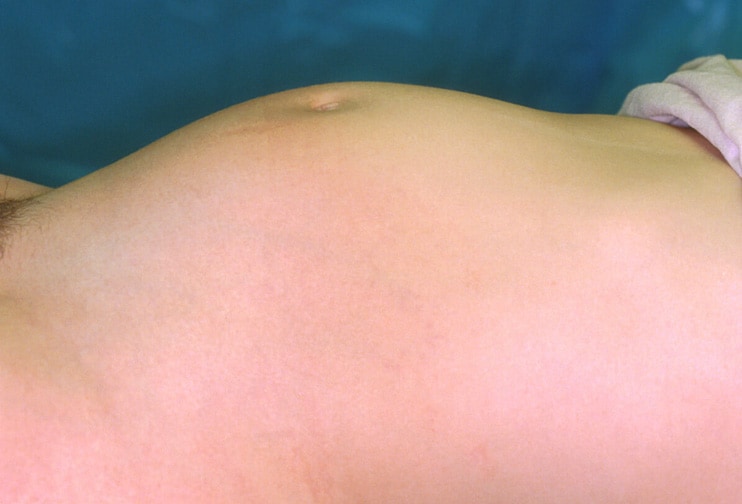

 This shows the names of the parts of the vulva. The rest of the illustrations do not have labels.
This shows the names of the parts of the vulva. The rest of the illustrations do not have labels.  This is a perfect annular hymen. It is called annular because the hymen forms a ring around the vaginal opening. As the hymen starts to erode from sexual or other activity, the hymen becomes less ring-like.
This is a perfect annular hymen. It is called annular because the hymen forms a ring around the vaginal opening. As the hymen starts to erode from sexual or other activity, the hymen becomes less ring-like.  This is a crescentic, or lunar, hymen. It forms a crescent shape, like a half moon, above or (as in this case) below the vaginal opening.
This is a crescentic, or lunar, hymen. It forms a crescent shape, like a half moon, above or (as in this case) below the vaginal opening.  The hymen of a female with some sexual or masturbatory (internal) experience is apt to look something like this. Note that it is much less ring-like than the annular hymen.
The hymen of a female with some sexual or masturbatory (internal) experience is apt to look something like this. Note that it is much less ring-like than the annular hymen.  This is what the hymen of a female who has only had a small amount of sexual activity or object insertion would look like. Health professionals who examine hymens for signs of sexual abuse are usually most interested in the posterior part of the hymen, from the 3 o'clock to 9 o'clock position. This is normally where the hymen breaks when the vagina is first penetrated.
This is what the hymen of a female who has only had a small amount of sexual activity or object insertion would look like. Health professionals who examine hymens for signs of sexual abuse are usually most interested in the posterior part of the hymen, from the 3 o'clock to 9 o'clock position. This is normally where the hymen breaks when the vagina is first penetrated.  This is the vulva of a woman who has given birth. The hymen is completely gone, or nearly so.
This is the vulva of a woman who has given birth. The hymen is completely gone, or nearly so.  One in 2000 girls is born with an imperforate hymen. A doctor will do surgery to create a hole in the hymen of such a newborn.
One in 2000 girls is born with an imperforate hymen. A doctor will do surgery to create a hole in the hymen of such a newborn.  This is a rare cribriform hymen, characterized by many small holes. This type of hymen lets menstrual and other fluids out with no problem, but sexual activity and the insertion of tampons can be problematic.
This is a rare cribriform hymen, characterized by many small holes. This type of hymen lets menstrual and other fluids out with no problem, but sexual activity and the insertion of tampons can be problematic.  This is a rare denticular hymen, so called because it looks like a set of teeth surrounding the vaginal opening.
This is a rare denticular hymen, so called because it looks like a set of teeth surrounding the vaginal opening.  This is a rare fimbriated hymen, with an irregular pattern around the vaginal opening.
This is a rare fimbriated hymen, with an irregular pattern around the vaginal opening.  This rare labial hymen looks like a third set of vulvar lips.
This rare labial hymen looks like a third set of vulvar lips.  Some girls are born with only a tiny hole in their hymens. Surgery is also necessary for these newborns to create a larger vaginal opening.
Some girls are born with only a tiny hole in their hymens. Surgery is also necessary for these newborns to create a larger vaginal opening.  This rarity is called a septate hymen because of the piece of hymen that makes a septum, or bridge, across the vaginal opening.
This rarity is called a septate hymen because of the piece of hymen that makes a septum, or bridge, across the vaginal opening.  This is the rare subseptate hymen, similar to the septate hymen only not making a bridge all the way across. Doesn't this remind you of the view into your throat with the uvula hanging down?
This is the rare subseptate hymen, similar to the septate hymen only not making a bridge all the way across. Doesn't this remind you of the view into your throat with the uvula hanging down?